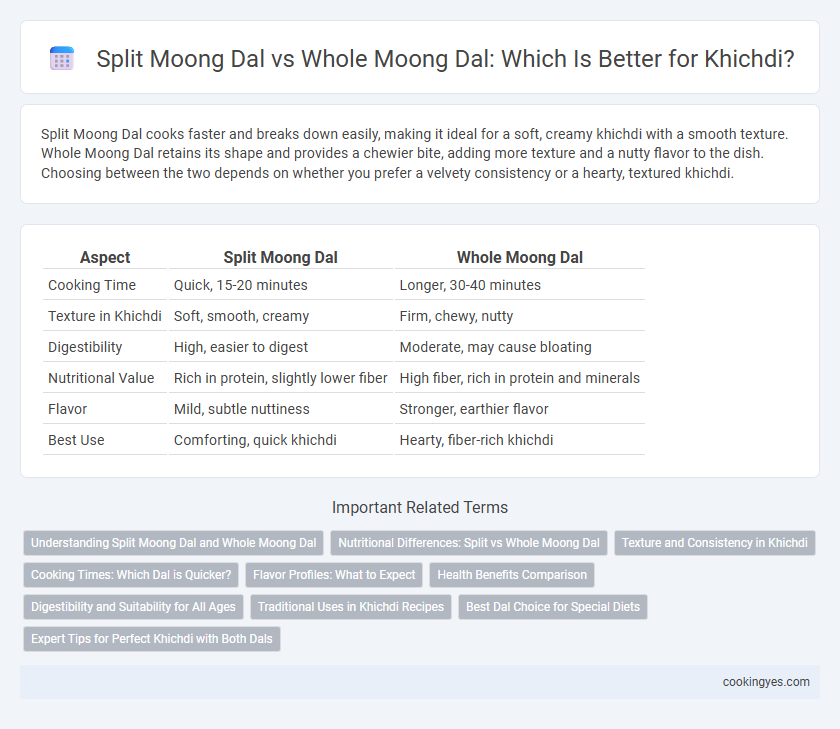Split Moong Dal cooks faster and breaks down easily, making it ideal for a soft, creamy khichdi with a smooth texture. Whole Moong Dal retains its shape and provides a chewier bite, adding more texture and a nutty flavor to the dish. Choosing between the two depends on whether you prefer a velvety consistency or a hearty, textured khichdi.
Table of Comparison
| Aspect | Split Moong Dal | Whole Moong Dal |
|---|---|---|
| Cooking Time | Quick, 15-20 minutes | Longer, 30-40 minutes |
| Texture in Khichdi | Soft, smooth, creamy | Firm, chewy, nutty |
| Digestibility | High, easier to digest | Moderate, may cause bloating |
| Nutritional Value | Rich in protein, slightly lower fiber | High fiber, rich in protein and minerals |
| Flavor | Mild, subtle nuttiness | Stronger, earthier flavor |
| Best Use | Comforting, quick khichdi | Hearty, fiber-rich khichdi |
Understanding Split Moong Dal and Whole Moong Dal
Split moong dal and whole moong dal differ primarily in their husk presence, affecting cooking time and texture in khichdi. Split moong dal, with the husk removed, cooks faster and yields a softer consistency, ideal for creamy khichdi. Whole moong dal retains its outer skin, providing a nuttier flavor and firmer texture, which results in a more substantial khichdi experience.
Nutritional Differences: Split vs Whole Moong Dal
Split Moong Dal contains less dietary fiber compared to Whole Moong Dal, as the husk is removed during the splitting process, resulting in faster digestion and absorption. Whole Moong Dal retains the bran and germ, providing higher amounts of protein, vitamins, and minerals like iron and potassium, making it more nutrient-dense. For khichdi, using Whole Moong Dal enhances fiber intake and micronutrient profile, while Split Moong Dal offers easier digestibility and quicker cooking time.
Texture and Consistency in Khichdi
Split Moong Dal results in a softer, creamier texture in khichdi due to its reduced cooking time and ability to break down easily, creating a smooth consistency. Whole Moong Dal retains a firmer texture and more bite, offering a slightly grainy consistency that adds a different mouthfeel to the dish. Choosing between split and whole moong dal depends on the desired texture--smooth and velvety versus hearty and chewy--in khichdi preparation.
Cooking Times: Which Dal is Quicker?
Split Moong Dal cooks significantly faster than Whole Moong Dal, typically taking around 15-20 minutes compared to the 40-50 minutes required for whole moong. The removal of the husk in Split Moong Dal allows water to penetrate more easily, resulting in quicker softening and ideal texture for khichdi. Choosing Split Moong Dal reduces overall cooking time, making it a preferred option for faster meal preparation.
Flavor Profiles: What to Expect
Split Moong Dal offers a mild, nutty flavor with a slightly creamy texture, making it ideal for khichdi that is smooth and easy to digest. Whole Moong Dal provides a stronger, earthier taste with a firmer bite, adding more depth and texture to the dish. Choosing between the two depends on preference for either a delicate or robust flavor profile in khichdi.
Health Benefits Comparison
Split Moong Dal is easier to digest and cooks faster, making it ideal for light, nutritious khichdi rich in protein and dietary fiber. Whole Moong Dal retains the bran, providing higher levels of antioxidants, vitamins, and minerals that support heart health and boost immunity. Both varieties offer essential amino acids and slow-release carbohydrates, promoting sustained energy and better blood sugar control.
Digestibility and Suitability for All Ages
Split Moong Dal is easier to digest due to its reduced fiber content, making it ideal for all ages, especially young children and the elderly. Whole Moong Dal, while nutritionally richer with intact fiber and protein, may be harder to digest and better suited for those with a more robust digestive system. For khichdi, split moong dal ensures a softer texture and quicker cooking time, enhancing digestibility and overall suitability for a wide range of dietary needs.
Traditional Uses in Khichdi Recipes
Split Moong Dal is preferred in traditional khichdi recipes for its quick cooking time and smooth texture, enhancing digestibility and creaminess. Whole Moong Dal, while less common, adds a nuttier flavor and firmer bite, aligning with regional variations that value texture contrast. Both dals offer high protein content and are integral to authentic Indian comfort food, supporting balanced nutrition in traditional meals.
Best Dal Choice for Special Diets
Split Moong Dal cooks faster and is easily digestible, making it ideal for light, protein-rich khichdi suitable for special diets like low-fiber or diabetic meal plans. Whole Moong Dal retains more fiber and nutrients, offering a heartier texture and enhanced vitamin content, preferred in diets emphasizing sustained energy and digestive health. Selecting between split and whole moong dal impacts nutritional profile, cooking time, and suitability for specific dietary needs such as weight management or renal-friendly menus.
Expert Tips for Perfect Khichdi with Both Dals
Split Moong Dal cooks faster and yields a softer texture ideal for creamy khichdi, while Whole Moong Dal provides a nuttier flavor and firmer bite, enhancing the dish's nutritional profile with higher fiber content. Experts recommend soaking Whole Moong Dal for 6-8 hours to reduce cooking time and improve digestibility, whereas Split Moong Dal requires minimal soaking due to its faster cooking properties. For perfect khichdi, balance spices like cumin and asafoetida, and adjust water quantity--less for split dal and more for whole dal--to achieve a harmonious consistency.
Split Moong Dal vs Whole Moong Dal for Khichdi Infographic

 cookingyes.com
cookingyes.com